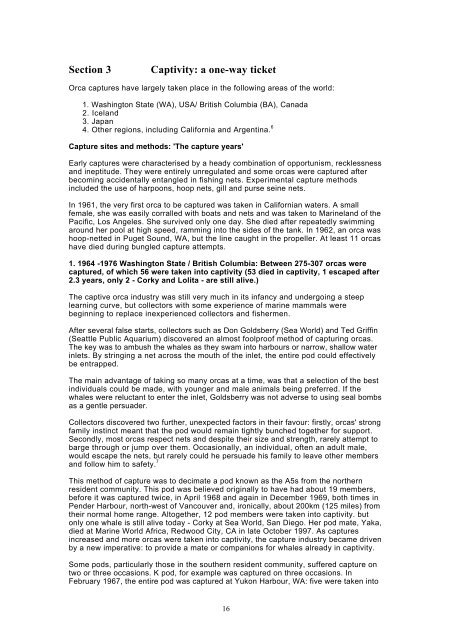Captive Orcas 'Dying to Entertain You' - Whale and Dolphin ...
Captive Orcas 'Dying to Entertain You' - Whale and Dolphin ...
Captive Orcas 'Dying to Entertain You' - Whale and Dolphin ...
You also want an ePaper? Increase the reach of your titles
YUMPU automatically turns print PDFs into web optimized ePapers that Google loves.
Section 3Captivity: a one-way ticketOrca captures have largely taken place in the following areas of the world:1. Washing<strong>to</strong>n State (WA), USA/ British Columbia (BA), Canada2. Icel<strong>and</strong>3. Japan4. Other regions, including California <strong>and</strong> Argentina. 6Capture sites <strong>and</strong> methods: 'The capture years'Early captures were characterised by a heady combination of opportunism, recklessness<strong>and</strong> ineptitude. They were entirely unregulated <strong>and</strong> some orcas were captured afterbecoming accidentally entangled in fishing nets. Experimental capture methodsincluded the use of harpoons, hoop nets, gill <strong>and</strong> purse seine nets.In 1961, the very first orca <strong>to</strong> be captured was taken in Californian waters. A smallfemale, she was easily corralled with boats <strong>and</strong> nets <strong>and</strong> was taken <strong>to</strong> Marinel<strong>and</strong> of thePacific, Los Angeles. She survived only one day. She died after repeatedly swimmingaround her pool at high speed, ramming in<strong>to</strong> the sides of the tank. In 1962, an orca washoop-netted in Puget Sound, WA, but the line caught in the propeller. At least 11 orcashave died during bungled capture attempts.1. 1964 -1976 Washing<strong>to</strong>n State / British Columbia: Between 275-307 orcas werecaptured, of which 56 were taken in<strong>to</strong> captivity (53 died in captivity, 1 escaped after2.3 years, only 2 - Corky <strong>and</strong> Lolita - are still alive.)The captive orca industry was still very much in its infancy <strong>and</strong> undergoing a steeplearning curve, but collec<strong>to</strong>rs with some experience of marine mammals werebeginning <strong>to</strong> replace inexperienced collec<strong>to</strong>rs <strong>and</strong> fishermen.After several false starts, collec<strong>to</strong>rs such as Don Goldsberry (Sea World) <strong>and</strong> Ted Griffin(Seattle Public Aquarium) discovered an almost foolproof method of capturing orcas.The key was <strong>to</strong> ambush the whales as they swam in<strong>to</strong> harbours or narrow, shallow waterinlets. By stringing a net across the mouth of the inlet, the entire pod could effectivelybe entrapped.The main advantage of taking so many orcas at a time, was that a selection of the bestindividuals could be made, with younger <strong>and</strong> male animals being preferred. If thewhales were reluctant <strong>to</strong> enter the inlet, Goldsberry was not adverse <strong>to</strong> using seal bombsas a gentle persuader.Collec<strong>to</strong>rs discovered two further, unexpected fac<strong>to</strong>rs in their favour: firstly, orcas' strongfamily instinct meant that the pod would remain tightly bunched <strong>to</strong>gether for support.Secondly, most orcas respect nets <strong>and</strong> despite their size <strong>and</strong> strength, rarely attempt <strong>to</strong>barge through or jump over them. Occasionally, an individual, often an adult male,would escape the nets, but rarely could he persuade his family <strong>to</strong> leave other members<strong>and</strong> follow him <strong>to</strong> safety. 7This method of capture was <strong>to</strong> decimate a pod known as the A5s from the northernresident community. This pod was believed originally <strong>to</strong> have had about 19 members,before it was captured twice, in April 1968 <strong>and</strong> again in December 1969, both times inPender Harbour, north-west of Vancouver <strong>and</strong>, ironically, about 200km (125 miles) fromtheir normal home range. Al<strong>to</strong>gether, 12 pod members were taken in<strong>to</strong> captivity. bu<strong>to</strong>nly one whale is still alive <strong>to</strong>day - Corky at Sea World, San Diego. Her pod mate, Yaka,died at Marine World Africa, Redwood City, CA in late Oc<strong>to</strong>ber 1997. As capturesincreased <strong>and</strong> more orcas were taken in<strong>to</strong> captivity, the capture industry became drivenby a new imperative: <strong>to</strong> provide a mate or companions for whales already in captivity.Some pods, particularly those in the southern resident community, suffered capture ontwo or three occasions. K pod, for example was captured on three occasions. InFebruary 1967, the entire pod was captured at Yukon Harbour, WA: five were taken in<strong>to</strong>16
















